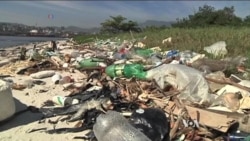A University of Georgia study released in February estimated 8-million tons of plastic garbage was dumped into the oceans in 2010.
In the Pacific Ocean, currents collect that plastic into a huge slowly spinning garbage patch where it poses a major environmental threat to sea life.
The culprit, researchers say, is plastic. Coming from virtually everywhere — a veritable river of garbage winding its way into the world's oceans — the trash concentrates in five of the Earth’s ocean gyres, which are naturally occurring circular currents, according to University of Hawaii marine scientist Dave Karl.
“As you get closer and closer to the central axis of that feature, the waters become more quiescent [calm]," says Karl, who is part of a team of Honolulu-based researchers tracking the huge Pacific trash patch and monitoring its impact on marine life. "So they tend to trap floating debris.”
The Pacific patch is famously as big as the U.S. state of Texas, but Karl says what is seen from passing ships or the air is mostly empty ocean.
“The impression that people got about this patch was that it was a solid mass of plastic," he says. "You could almost jump off your boat and walk across the state of Texas on this plastic footing. That is not the way it is at all.”
Oceanic churning quickly reduces much of the plastic to a chemical sludge, says Allen Clark of Hawaii's East-West Center. In that particular form, he says, it become even more dangerous to marine life, since tiny plankton organisms consume the particles.
“[The particles] are eaten by things like jellyfish, who turn out to be one of the favorite food of larger fish, and then you go through the food chain to tuna and things of this nature," he says. "All of this material, and particularly the carcinogens, which get broken down by the animals into the constituent parts that are really bad, that gets concentrated in the fatty tissues of the fish.”
And the cycle is completed, as this micro-plastic ends up on beaches, in the wildlife and even in the food that winds up on the dinner table. According to Karl, plastic ocean trash is mostly invisible. Some is in fluid form and some sinks to the bottom and cannot be seen, so, until recently, it was hard to measure.
“So when we are talking about this contemporary Great Pacific Plastic Patch, as it has been called, we are only skimming the surface, literally,” Karl says.
That same University of Georgia study says if the trends continue, we will be dumping 10 times as much plastic into the oceans during the next decade.
Scientists will continue to track the massive gyres, while on land there is ongoing research to determine if all this plastic might be harmful to humans.








